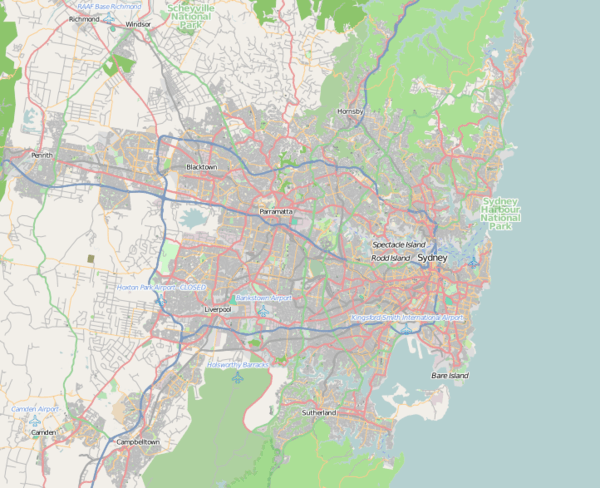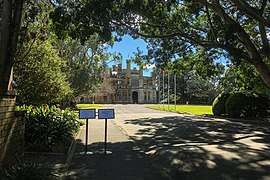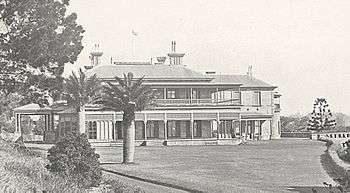Government House, Sydney
| Government House | |
|---|---|
 Main façade of Government House | |
 Government House, Sydney Location in Greater Sydney | |
| General information | |
| Type | Vice-regal residence |
| Architectural style | Gothic revival style |
| Location | Royal Botanic Gardens, Conservatorium Road, Bennelong Point, Sydney, New South Wales |
| Country | Australia |
| Coordinates | 33°51′36″S 151°12′54″E / 33.859919°S 151.215008°ECoordinates: 33°51′36″S 151°12′54″E / 33.859919°S 151.215008°E |
| Current tenants |
Governor of New South Wales (as the vice-regal representative of) The Queen of Australia |
| Construction started | 1837 |
| Completed | 1847 |
| Owner |
The Queen in Right of New South Wales (via the Department of Premier and Cabinet) |
| Design and construction | |
| Architect | |
| Architecture firm | Colonial Architect of New South Wales |
| Official name | Government House, Movable Heritage Collection and Gardens |
| Type | Complex / Group |
| Criteria | a., b., c., d., e., f. |
| Designated | 13 December 2011 |
| Reference no. | 01872 |
| [1][2][3] | |
The Government House is the vice-regal residence of the Governor of New South Wales, Australia, located on Conservatorium Road in Sydney alongside the Royal Botanic Gardens, overlooking Sydney Harbour, just south of the Sydney Opera House. Constructed between 1837 and 1843, the property has been the vice-regal residence of the Governor since Sir George Gipps, except for two brief periods; the first between 1901 and 1914, when the property was leased to the Commonwealth of Australia as the residence of the Governor-General of Australia,[4] and the second from 1996 to 2011.
The property was returned as the Governor's residence in October 2011[5] and was managed by the Historic Houses Trust of New South Wales from March 1996 to December 2013.[6] Completed in 1847 and constructed in the Gothic revival style, the building is listed on the New South Wales State Heritage Register.[1]
History
1845–1901
In 1845 the British Government agreed that a new Government House in Sydney had become a necessity, and the royal architect, Edward Blore, was instructed to draw up plans. Construction commenced in 1837 and was supervised by colonial architect Mortimer Lewis and Colonel Barney of the Royal Engineers.[7] Stone, cedar, and marble for the construction were obtained from various areas of New South Wales. A ball in honour of the birthday of Queen Victoria was held in the new building in 1843, although construction was not complete. The first resident, Governor George Gipps, did not move in until 1845.[7]
Government House, with its setting on Sydney Harbour, has a garden area of five hectares (twelve acres) and is located south of the Sydney Opera House, overlooking Farm Cove. It was designed in a romantic Gothic revival style – castellated, crenellated, turreted and is decorated with oil portraits and the coats of arms of its successive occupants. Additions have included a front portico in 1873, an eastern verandah in 1879 and extensions to the ballroom and governor's study in 1900–01.
From 1845 until 1901, the building served as the Governor's residence, office and official reception space.
1901–1914
Between 1901 and 1914, the building was used to house the new role of Governor-General, created by the Federation of Australia. During this period, three Governors of New South Wales occupied Cranbrook, namely Harry Rawson, Frederic Thesiger, 1st Viscount Chelmsford and Gerald Strickland, 1st Baron Strickland.[8][9]
In 1913, the decision was taken to establish a residence for the Governor-General at Admiralty House.[10]
1914–1996
.jpg)
From 1914 to 1996, the building again served as the residence, office and official reception space for the Governor of New South Wales.
1996–2011
However, in 1996, at the direction of the then Premier of New South Wales, Bob Carr, the property ceased to be used as a residence, and the Governor's day office was relocated to the historic Chief Secretary's building nearby, at 121 Macquarie Street.[11] On 16 January 1996 Carr announced that the next Governor, Gordon Samuels, would not live or work at Government House. On these changes, Carr said "The Office of the Governor should be less associated with pomp and ceremony, less encumbered by anachronistic protocol, more in tune with the character of the people".[12] Carr later quipped that his decision had been "for Jack Lang",[13] referring to the Premier of a former state Labor Government that was dismissed by a Governor, Philip Game, in 1932 during a constitutional crisis.
The state's longest-serving Governor, Sir Roden Cutler, was also reported as saying: "It's a political push to make way in New South Wales to lead the push for a republic. If they decide not to have a Governor and the public agrees with that, and Parliament agrees, and the Queen agrees to it, that is a different matter, but while there is a Governor you have got to give him some respectability and credibility, because he is the host for the whole of New South Wales. For the life of me I cannot understand the logic of having a Governor who is part-time and doesn't live at Government House. It is such a degrading of the office and of the Governor."[12]
This move generated further controversy, as the proclaimed cost savings of over $2 million never materialised. The Auditor-General found it cost $600,000 more to maintain the building without a resident Governor; and public attendance decreased (resident Governors had maintained public access during their tenures).[14] This led the group Australians for Constitutional Monarchy to organise a protest, resulting in one of the largest marches in Sydney history: a crowd of 15,000 protested outside Parliament House, blocking Macquarie Street.[15] On the day before Gordon Samuels' swearing-in, a petition bearing 55,000 signatures was handed in, calling on the Premier to reconsider.[16] During the hiatus of resident governor, Government House was consistently used for vice-regal purposes and remained the official reception space of the state, including as a key meeting venue of APEC Australia 2007 in September 2007, at which time the political leaders of the 21 member states of the Asia-Pacific Economic Cooperation met.
2011–present
In October 2011, the then Premier Barry O'Farrell announced that the then Governor, Marie Bashir, had agreed with O'Farrell's offer to move back into Government House: "A lot of people believe the Governor should live at Government House. That's what it was built for ... [A]t some stage a rural or regional governor will be appointed and we will need to provide accommodation at Government House so it makes sense to provide appropriate living areas". However, because Government House has not been a residence for fifteen years, O'Farrell also announced that the Governor will initially move into a smaller adjacent building, called the chalet, while refurbishments of the main wing occur, with a proposed move into the main house "before Christmas".[17] From December 2013, management of Government House was returned to the Office of the Governor from the managers since 1996, the Historic Houses Trust of New South Wales.[6]
Heritage listing
On 13 December 2011, the building and associated grounds and furnishings were listed on the New South Wales State Heritage Register with the following statement of significance:[1]
Government House built in the early 1840s as the home of the monarch's representative and as the seat of power, symbolised British authority in the colony. Like the Governors themselves, the house is a powerful symbol of state.
From the time of its completion, the house and its occupants were seen as the 'pinnacle' of society, and the Governor and family as social exemplars, ideas that continued well into the twentieth century. Home to twenty four governors of New South Wales and their families, and the first five Governors-General, all chosen for their various pre-eminent positions, it reflects the many changes that have taken place in public and private life. Guests and visitors ranged from citizens paying their respects or receiving awards, to the reigning monarch, Elizabeth II, other members of the Royal family and other heads of states.
The finest example of a castellated Gothic house in Australia, the house with its landscaped gardens reflected its English ties and was the model that inspired others. It is a grand ensemble of buildings, gardens and contents whose history and use are richly documented. Developments to the place over 150 years demonstrate changing tastes and social attitudes, and showcase the talents of leading architects, artists and craftsmen.
Located in Governor Phillip's domain, it provides a tangible link with the earliest years of the colony, and is associated with the development of significant public places such as the Conservatorium (formerly its stables), Royal Botanic Gardens (formerly its grounds), and the Opera House.
Government House in Sydney is significant as one of the two original official residences selected for the Governor-General following the federation of the Australian colonies in 1901. Rivalry between New South Wales and Victoria led the Commonwealth Government to designate Government House in Sydney and Melbourne Government House as official residences of equal status for the Governor-General. The Sydney Government House served as the governor-general's Sydney Residence until 1912 when the NSW government sparked a major controversy by effectively evicting the governor-general. The place is significant for its association with the first five occupants of the high office of Governor-General from the time of federation until 1912.
A rare example of a great harbourside landscape estate virtually intact. A typical 19th century 3-part estate landscape of park, parterre and pleasure grounds. The formal grounds of sweeping annual displays, manicured lawns, exotic trees and shrubs as well as the carriageways, paths and terraces provide a strong link with Sydney's colonial and Victorian heritage
It is perhaps the last of the great harbourside estates to have survived relatively intact and to still be carrying on its original function; a combination of private residence, office complex and official function venue. The garden is one of the oldest continually maintained gardens in Australia. Whilst it has been altered to some extent over the years, it nevertheless provides an appropriately grand setting for the house.
The heritage significance of Government House at a State level is enhanced by the extraordinarily rich and diverse collection of moveable heritage ranging from furniture, paintings, ceramics, glassware textiles and sculpture to garden ornaments and kitchenalia dating back to the 1820s. It is a rare and intact collection of items with a ongoing and continuous association with the vice regal function and clearly demonstrates 150 years of changing style and taste. The collection is inherently linked to the house (and specific locations in the house). The comprehensive collection of portraits of NSW governors contains one of the earliest official portraits to be commissioned in NSW and Australia, that of Governor Thomas Brisbane by Augustus Earle. The collection of colonial furniture is significant and contains the most extensive collection of furniture by noted craftsman Andrew Lenham between 1845 and 1860 as well as furniture and other objects associated with colonial and international exhibitions and demonstrate excellence in local design, manufacturing and materials.
— Statement of significance, New South Wales State Heritage Register.
Gallery
 Formal gateway and entrance drive to Government House, Sydney.
Formal gateway and entrance drive to Government House, Sydney. Cranbook, 1917.
Cranbook, 1917. Water fountain in the formal gardens on the eastern side of Government House.
Water fountain in the formal gardens on the eastern side of Government House. Garden features in the formal gardens on the eastern side of the house, with views across to Sydney Opera House.
Garden features in the formal gardens on the eastern side of the house, with views across to Sydney Opera House.
See also
- First Government House, Sydney, residence of the Governor from 1788 to 1845
- Old Government House, Parramatta, the country retreat for the early Governors
- Government Houses of Australia
- Government Houses in the Commonwealth
References
- 1 2 3 "Government House, Movable Heritage Collection and Gardens". New South Wales State Heritage Register. Office of Environment and Heritage. Retrieved 30 October 2017.
- ↑ "Government House, Conservatorium Rd, Sydney, NSW, Australia (Place ID 1866)". Australian Heritage Database. Department of the Environment. Retrieved 30 October 2017.
- ↑ "Government House, Associated Buildings and Garden, Conservatorium Rd, Sydney, NSW, Australia (Place ID 102246)". Australian Heritage Database. Department of the Environment. Retrieved 30 October 2017.
- ↑ "Historic Houses Trust". Government House Guide. Retrieved 8 October 2011.
- ↑ "Governor Marie Bashir makes a grand return home to Government House". The Daily Telegraph. 7 October 2011.
- 1 2 "Government House". Government House, Sydney. Governor of New South Wales.
- 1 2 "The Governor of NSW: Government House". Parliament of New South Wales. NSW Government. Archived from the original on 28 January 2010. Retrieved 10 December 2010.
- ↑ "SOCIAL". The Sydney Morning Herald. National Library of Australia. 5 October 1901. p. 7. Retrieved 22 December 2013.
- ↑ "THE NEW GOVERNOR". The Sydney Morning Herald. National Library of Australia. 4 February 1902. p. 5. Retrieved 22 December 2013.
- ↑ "A brief history of Admiralty House, Sydney". Governor-General of Australia. Retrieved 22 December 2013.
- ↑ "The Governor of NSW: The Governor's Office". Parliament of New South Wales. NSW Government. Archived from the original on 28 January 2010. Retrieved 12 December 2010.
- 1 2 "Editorial – A Governor on the side". The Sydney Morning Herald. 17 January 1996.
- ↑ Parliament of New South Wales, Hansard, Constitution Amendment (Office of Governor) Bill: Queen-in-Right-of-New-South-Wales
|access-date=requires|url=(help) - ↑ Humphries, David (13 November 1997). "Blow-out in costs for "empty" residence". The Sydney Morning Herald.
- ↑ Richards, George (1 March 1996). "Era ends as door closes on Governor's home". The Sydney Morning Herald.
- ↑ Lunn, Stephen (1 March 1996). "Monarchists decry Carr's "republic by stealth"". The Australian.
- ↑ "Governor Marie Bashir makes a grand return home to Government House". The Daily Telegraph. 7 October 2011.
Attribution
![]()
External links
| Wikimedia Commons has media related to Government House, Sydney. |
- Government House section of Governor's Website
- Official Government House website (Historic Houses Trust)
- Old Government House Website
- Old Government House (NSW National Trust)
- School excursion information – Old Government House
- Australian National Heritage listing for Old Government House and Government Domain
- Pictures of Old Government House, Parramatta
- Ellmoos, Laila (2008). "Government House". Dictionary of Sydney. Dictionary of Sydney Trust. Retrieved 11 October 2015. [CC-By-SA]